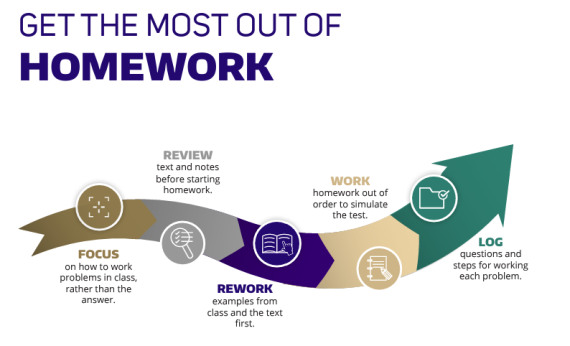Treat all the problems in your course—not just those on the real exam or quiz—as a chance to test yourself on your understanding. Don’t assume that simply reading through the solution to a problem means that you can solve it. You must practice the problem-solving steps yourself without assistance to build this kind of knowledge!
FOCUS
In class, focus on the process of solving problems, NOT JUST the final answer. The final answer is often the least useful part of a worked example, as far as learning the material goes. The logic behind each step in a solution is far more important; if you understand the general steps, you can apply them to new situations (like on the test!).
REVIEW
Before you begin your homework, review your notes from class and the textbook to refresh your memory of the relevant concepts.
REWORK
Rework examples from class and the textbook WITHOUT looking at the solution, your notes, the textbook, or any other resource.
- Do your very best to complete the entire problem before you check your answer
- When you are finished, check only your final answer, not your entire solution. If your result is incorrect, go back through your notes and the textbook to investigate where and why you made mistakes...this is when the best and deepest learning takes place!
- When you obtain the correct answer, compare your approach to the solution. Consider the following questions:
- Is your approach basically the same, or does it differ in key ways?
- If your approach is different, is it physically valid, or did you obtain the correct answer accidentally?
- Are there other valid methods for solving the problem?
“What if I don’t even know how to get started?”
Sometimes, you may feel completely stumped by a problem. If this happens, set a timer for five minutes, and look through your notes or the textbook to figure out how to begin. If you’re still stuck, look at just the first step of the worked solution (cover the rest with a piece of paper), and give yourself another five minutes to work step two. Continue in this fashion until you have solved the entire problem.
WORK
Notice that the steps above in REWORK give you the opportunity to practice with a “safety net”—that is, the full solutions to worked examples from class and the textbook. This approach allows you to build the intellectual confidence to approach new problems that don’t come with a complete solution.
When work on your homework, simulate an exam situation:
- Work questions out of order. Problems from the end of the chapter, class worksheets, or online homework assignments often appear in the same order that you learned the concepts in class, which provides subtle context clues about what kind of problems they are. Exam/quiz questions often do not appear in chronological order, so you have nothing but the problem statement itself to rely on. Remove context clues from your homework by solving the problems in different order than assigned.
- Do not look at your notes or solutions to similar problems. Most exams or quizzes are closed-note and closed-book. Don’t rely on your notes and book to solve your homework problems. You likely won’t have access to these resources on the real test.
- Give yourself a time limit. Most exams and quizzes are delivered during a fixed time period. Prepare for this by limiting the amount of time you allow yourself for completing your homework problems.
LOG
- Keep a log of the problems you’ve done and the steps you used to solve them.
- Compare and contrast your approaches to problems within and between homework sets...what similarities do you notice? what differences?
Information in the Catalyze Your Success program has been adapted from learning strategies presented by the Louisiana State University Center for Academic Success and the book "Teach Students How to Learn" by Saundra Yancy McGuire, Stylus Publishing (2021).
